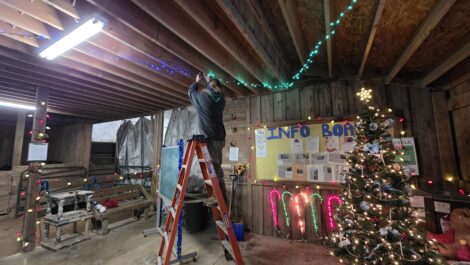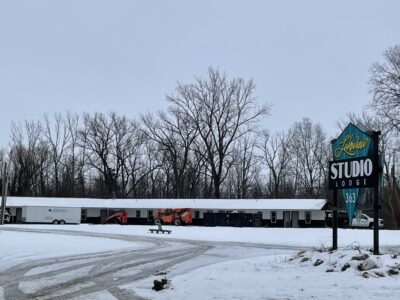Debating the turbines
As state seeks comment for wind towers, opposition hires attorney

OBSERVER Photos by Damian Sebouhian Seen are images from a wind farm construction site off of Center Road in Arkwright.
The New York State Board on Electric Generation and the Environment (Siting Board) issued a public notice regarding a recent wind farm decision made by judges from the Department of Public Service (DPS) and the Department of Environmental Conservation on Wednesday.
The two departments are recommending that the Siting Board grant a certificate to Cassadaga Wind LLC, allowing the construction and operation of a wind farm in the towns of Charlotte, Cherry Creek, Arkwright and Stockton.
According to the Siting Board’s notice, the wind farms would consist of “up to 48 wind turbines and associated facilities, with numerous conditions designed to minimize the impacts to the local community.”
As part of the Article 10 process for public engagement, the Siting Board is calling for public comments on the recommended decision. All comments should be submitted by Nov. 28.
The notice includes information about the Cassadaga project application, filed on June 16, 2016.
“The application sought approval for the construction and operation of a 126 megawatt wind energy project, including the installation and operation of up to 58 wind turbines with associated underground and above-ground transmission lines, access roads, meteorological towers, operation and maintenance building, collection and point of interconnect substations, and related facilities.”
The Siting Board will review and vote on whether to issue the certificate, with the final decision scheduled to be made sometime in January 2018.
According to the notice, the public may submit comments directly into the case file by locating the case via the home page of the Department of Public Service’s website, www.dps.ny.gov, by clicking on “Search,” and entering “14-F-0490” in the “Search by Case Number” field. In the open case, access the screen to enter comments by clicking on the “Post Comments” box located at the top of the page.
Comments can also be made by calling the Commission’s Opinion Line at 1-800-335-2120. This line is set up to receive in-state calls 24-hours a day. Callers should refer to the case number or the applicant’s name, Cassadaga Wind.
The full RD can be viewed here: http://documents.dps.ny.gov/public/Common/ViewDoc.aspx?DocRefId={9D06B757-3F63-40BE-B944-2DF4C5477BEC}
Concerned Citizens still fighting
Members of the group Concerned Citizens of Cassadaga Wind Project, acting as interveners, have hired environmental lawyer Gary Abraham, in their fight to try and stop the Cassadaga wind project.
Abraham said that although the Siting Board is scheduled to make their final decision by mid-January, that decision isn’t necessarily going to be a black-and-white one; approve or disapprove.
“It’s more complicated than that,” Abraham told the OBSERVER. “They could not allow it, they could decide not to issue a certificate of public convenience and necessity, or they could issue the certificate with conditions and there are several conditions that are being proposed by the Public Service Commission’s own staff.”
Abraham said that some of the requirements the DEC is pondering are costly, including protecting bats and birds.
“They are also asking that they modify where the electrical lines are installed to avoid guide wires which take out agricultural land.”
Abraham said that the certificate could get issued, but that the conditions included with the certificate might be deemed too costly, resulting in Everpower Wind Holdings, Inc. abandoning the project.
“For example, the DPS, they have lots of experts and attorneys; they’re recommending that 12 turbines be removed from the project,” Abraham said.
“There’s a lot more to go because once the examiners issue their recommended decision, it doesn’t just go straight to the siting board. The parties can then file briefs on exemptions, which is really just a fancy way of saying pointing out places they think the examiners decision was an error. (It’s about) really trying to get the hearing examiners to reconsider (their recommendation), pointing them to something they might have missed in the record.
“There’s a round of that, then the hearing examiners respond. Then all of that, plus the record of everybody that’s on the docent sheet, all of that goes to the Siting Board.”
The recommendation, penned by presiding examiner Dakin Lecakes and associate examiner P. Nicholas Garlick make note that changes have already been made to the initial Cassadaga Wind application.
“As described in the application when Cassadaga Wind was proposing 58 turbines, the project included the construction of approximately 16.6 miles of access roads to access the turbine locations and approximately 29.2 miles of overhead and underground 34.5 kV collection lines interconnecting the turbine locations.
“These total impacts have been reduced by the reduction in the number of turbines. The Project still includes construction of a 5.5-mile above ground 115 kV generator lead line, a collection substation, a point of interconnection with the New York State electric grid through facilities owned and operated by Niagara Mohawk Power Corporation d/b/a National Grid, two permanent meteorological (met) towers, two temporary staging/laydown yards for construction, and an Operations and Maintenance (O&M) building.”
Currently there have been 71 public comments posted to the DPS case file page, the majority voicing opposition to the project, although many are multiple arguments coming from various members of Concerned Citizens and don’t represent 71 individuals.
Those voicing their support for the project have generally cited the economic benefits they believe will come with the wind farms.
“The local economic boost to the communities and residents far outweighs any negative impact,” stated Cherry Creek resident Tom Reynolds.
“It will bring tax revenue, help landowners with additional income to support their farms. … Our local businesses will see an increase in business during construction, and even after with product and services needed to maintain the wind farm,” commented Merle Goot Jr.
On the other side, many opposed to the wind farm projects cited negative impacts on health, property values, wildlife, agricultural lands and much more.
“Industrial wind power has the effect of increasing rather than decreasing the emissions of conventional pollutants and greenhouse gases because they are so unreliable they have to be backed up with conventional coal or gas fired power plants. Gas or coal plants have to be cycled up and down depending on wind conditions,” stated Mayville resident Karen Engstrom. “The cycling of the backup plants means they have to be run inefficiently, which increases their emissions. Engineering studies in Colorado and Texas have found exactly that. Once wind power reaches a certain market share, about 10 percent more emissions occur than if an equal amount of power was created without wind power.”
Several politicians, during the run-up to Tuesday’s election expressed doubt and outright opposition to the wind farm project, including both candidates for county executive.
During a debate at Dunkirk City Hall, Mike Ferguson said, when asked about renewable energy: “I’m currently investigating wind mills that are being used in Europe which are much more environmentally friendly and which actually draw the wind in with a covered front location so you don’t have the problem with birds and bats that we may see with the large blades. (They) actually generate a more clean and efficient energy than what we’re currently seeing.”
Winner in that race, George Borrello, stated his adamant opposition to the wind farms: “Alternative energy is all well and good if it’s not 100 percent subsidized like it is now by our federal government. That’s the problem. There is no profit in it. The windmills that Mr. Ferguson is talking about, I agree with; those would be great windmills. That’s not what we’re putting in Chautauqua County. We’re putting in the old fashioned foreign-made 500-foot tall leviathans that are going to destroy our natural environment.”






